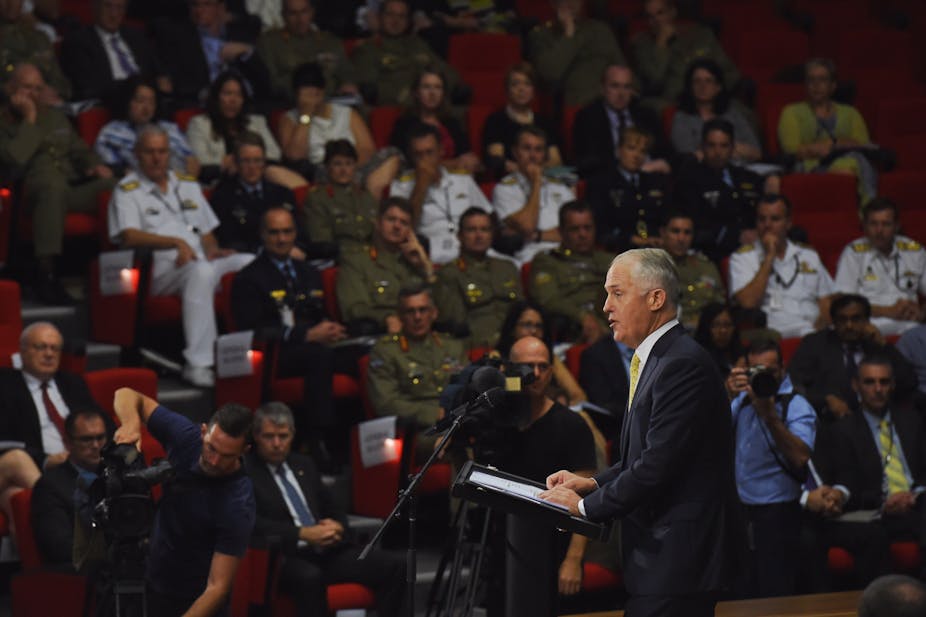The Turnbull government’s defence white paper identifies uncertainties in the US-China relationship, the spread of violent extremism, and emerging cyber threats as key risks to Australia’s security environment in the next two decades.
In what it describes as the most comprehensive such paper in Australia’s history, the government says defence spending will rise to 2% of GDP by 2020-21, three years earlier than its commitment. The paper provides a fully integrated investment program in new weapons, platforms, infrastructure and science and technology.
Spending is projected to rise from more than A$32 billion in 2016-17 to just under $59 billion in 2025-26, including $195 billion in capital investment to 2026. Capital investment will rise from 29% of the defence budget in 2016-17 to 39% in 2025-26. The majority of additional funding to 2025-26 is allocated from 2019-20, when major funding for new capabilities is required.
The paper says the roles of the US and China and their relationship will continue to be the most strategically important factors in the Indo-Pacific region to 2035.
“The United States will remain the pre-eminent global military power over the next two decades,” it says. While China will not match the global strategic weight of the US, the growth of its power including its military modernisation means it will have a major impact on the region’s stability to 2035.
Though careful with its language about China, the paper bluntly highlights the dangers of its activities in the South China Sea.
“Australia opposes the use of artificial structures in the South China Sea for military purposes,” it says. “Australia is particularly concerned by the unprecedented pace and scale of China’s land reclamation activities.”
The planned investment in new capability over future decades includes:
a continuous naval shipbuilding program commencing with nine replacement frigates and 12 offshore patrol vessels;
12 new submarines – with a commitment to maximise Australian industry involvement in their acquisition and sustainment; and
enhanced intelligence, surveillance and reconnaissance, space, electronic warfare and cyber capabilities.
There will be comprehensive upgrades to defence infrastructure across Australia to support a larger future force.
Six key drivers will shape Australia’s security environment in the next two decades, the paper says. These are:
the role of the US and China and their relationship;
challenges to the stability of the rules based global order;
the enduring threat of terrorism;
state fragility within our immediate neighbourhood;
the pace of military modernisation and the development of more capable military forces; and
the emergence of new complex, non-geographical threats, including cyber threats.
Launching the paper, Prime Minister Malcolm Turnbull said: “This white paper is a plan to deliver a more potent and agile and engaged defence force that is ready to respond whenever our interests are threatened or our help is needed.”
“It is a plan to become more powerful on the land and in the skies and more commanding both on the seas and beneath them. It is a program to be more resilient in the cyber space, to be more innovative with technology, and to have greater situational awareness, thanks to our advanced intelligence capabilities.”
The government was committed to this significant increase in spending for two reasons. “We recognise that Australia’s strategic environment is the most dynamic and challenging one that we have faced in peace time. We are also susceptible to the potential threats of conflict, climate change, malicious cyber activists, pandemic disease and transnational terrorism.”
Turnbull admitted that the quickening pace of defence spending had an impact on budget repair but said “it is part of a critically important investment in ensuring that our defence forces have the capability they need”.
Turnbull was anxious to emphasise that the white paper was “more than simply a road map to achieve a strong and sustainable defence capability”.
“Our investments in Australian industry and technologies will generate benefits beyond the Australian defence industrial base. It is worth remembering that some of our most significant technology of the 20th and 21st centuries originated as military investments.”
The government will invest $1.6 billion over ten years in programs to build industry skills, drive competitiveness and export potential while harnessing innovation and expertise.
Labor spokesman Stephen Conroy said the opposition was broadly supportive of the white paper, although it would closely scrutinise the funding commitment. But he noted that it had not promised to build the submarines in South Australia.
He said the government should call the Chinese ambassador in and ask for an explanation of its activity in the South China Sea.
US ambassador John Berry said the white paper “represents a well-considered, comprehensive approach to addressing evolving security challenges of the coming decades.
"As allies, we welcome the government’s sustained investment in defence capabilities and readiness and its support for rules-based international order,” Berry said.
Update
The ABC reports that Chinese Foreign Ministry spokeswoman Hua Chunying said China was “dissatisfied” with what it saw as the white paper’s “negative” comments about the South China Sea.
Hua said the paper mentioned Australia was willing to enhance cooperation with China, which China welcomed, hoping these positive statements could be translated into concrete actions.
“We also noticed that this white Paper made some remarks about South China Sea and East China Sea. These remarks are negative and we are dissatisfied about this.”

